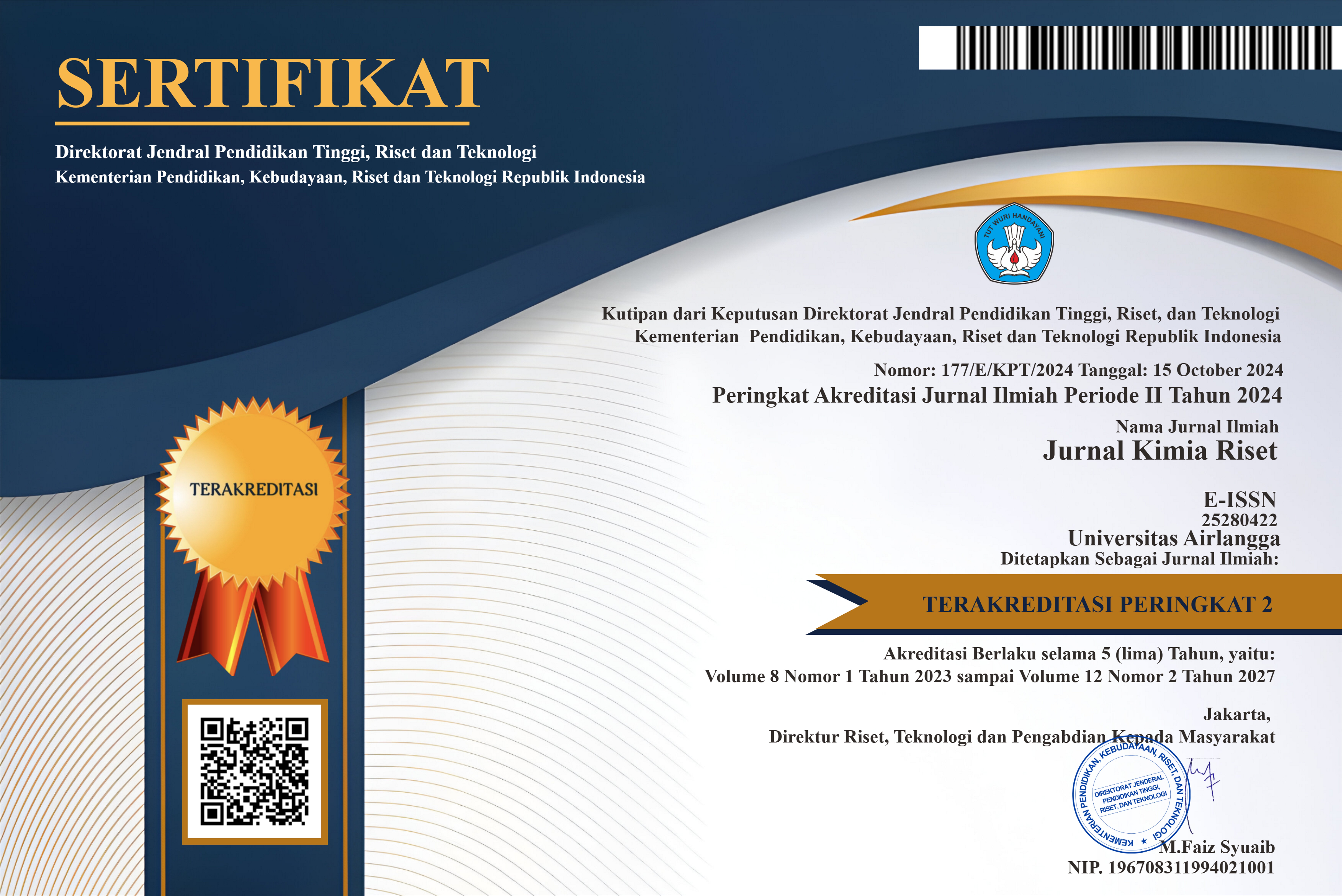INFLUENCE OF SOLID PARTICLE AND SOYBEAN OIL OF PICKERING EMULSION DICLOFENAC DIETHYLAMINE USING TAGUCHI METHOD
Downloads
Emulsions stabilized by solid particles are called Pickering emulsions, using diclofenac diethylamine for topical use. In this study, screening for the effect of the type of solid particles (bentonite 3%; Avicel RC-591 2.5%; and kaolin 15%) and soybean oil concentration (10%; 20%, and 30%) using the Taguchi orthogonal array method, with independent variables (type of solid particles and concentration of soybean oil, dependent variables (viscosity, pH, %EE, creaming index, globule size, and % cumulative penetration). The Pickering emulsion with Avicel RC-591 for solid particles produced a stable emulsion during 21 days of storage. Using the Taguchi orthogonal array method, the best formula based on the dependent variable is Formula 4 with physical test results at viscosity 566 cp, pH value 8.18, adsorption efficiency 55.70%, creaming index 100%, globule size 57.1 µm, cell diffusion Franz test at 120 minutes resulted in a cumulative penetration of 69.829%. The penetration power of Formula 4 is better than the emulsion with tween and span emulsifiers, which has a cumulative amount at 120 minutes of 12.609%. Therefore, Avicel RC-591 2.5% solid particles with 10% soybean oil concentration resulted in a stable Pickering emulsion and better penetration than emulsions with tween and span emulsifiers.
Ahsan, H.M., Zhang, X., Liu, Y., Wang, Y., Li, Y., Li, B., Wang, J. and Liu, S., 2020. Stable cellular foams and oil powders derived from methylated microcrystalline cellulose stabilized Pickering emulsions. Food Hydrocolloids, 104.
Alcí¢ntara, M.A., Lima, A.E.A. de, Braga, A.L.M., Tonon, R.V., Galdeano, M.C., Mattos, M. da C., Brígida, A.I.S., Rosenhaim, R., Santos, N.A. dos and Cordeiro, A.M.T. de M., 2019. Influence of the emulsion homogenization method on the stability of chia oil microencapsulated by spray drying. Powder Technology, 354, pp.877–885.
Aprilyanti, S. and Suryani, F., 2020. Penerapan Desain Eksperimen Taguchi Untuk Meningkatkan Kualitas Produksi Batu Bata Dari Sekam Padi. J@ti Undip: Jurnal Teknik Industri, 15(2), pp.102–108.
Atikah, 2017. Efektifitas Bentonit Sebagai Adsorben Pada Proses. 2(2), pp.23–32.
Da Costa, S., Basri, M., Shamsudin, N. and Basri, H., 2014. Stability of Positively Charged Nanoemulsion Formulation Containing Steroidal Drug for Effective Transdermal Application. Journal of Chemistry, 2014.
Daniel, T., 2016. Peningkatan Kepolaran Asam Linoleat Dalam Bentuk Amida Menjadi N-etanol-9,10,12,13,15,16 Heksahidroksi Oleil-Amida. Jurnal Kimia Mulawarman, 13 (2).
Dickinson, E., 2010. Food emulsions and foams: Stabilization by particles. Current Opinion in Colloid and Interface Science, 15(1–2), pp.40–49.
Falahi, A., Indah, C. and Indriyani, E., 2022. Stabilitas Fisik Emulgel Meloksikam Menggunakan Metode Freeze Thaw. Jurnal Ilmiah Farmasi Akademi Farmasi Jember, 4(2), pp.7–14.
Fitriani, E.W., Imelda, E., Kornelis, C. and Avanti, C., 2016. Karakterisasi dan Stabilitas Fisik Mikroemulsi Tipe A/M Dengan Berbagai Fase Minyak. Pharmaceutical Sciences and Research, 3(1), pp.31–44.
Guillot, S., Bergaya, F., de Azevedo, C., Warmont, F. and Tranchant, J.F., 2009. Internally structured Pickering emulsions stabilized by clay mineral particles. Journal of Colloid and Interface Science, 333(2), pp.563–569.
Kargar, M., Fayazmanesh, K., Alavi, M., Spyropoulos, F. and Norton, I.T., 2012. Investigation into the potential ability of Pickering emulsions (food-grade particles) to enhance the oxidative stability of oil-in-water emulsions. Journal of Colloid and Interface Science, 366(1), pp.209–215.
Kemenkes, RI., 1995. Farmakope Indonesia Edisi IV.
Kemenkes, RI., 2020. Farmakope Indonesia Edisi VI.
Kpogbemabou, D., Lecomte-nana, G., Aimable, A., Bienia, M., Niknam, V. and Carrion, C., 2014. Colloids and Surfaces A : Physicochemical and Engineering Aspects Oil-in-water Pickering emulsions stabilized by phyllosilicates at high solid content. Colloids and Surfaces A: Physicochemical and Engineering Aspects, 463, pp.85–92.
Lestari, S., Yuningsih, L.M. and Muharam, S., 2022. Hidrogel Superabsorben Berbasis Natrium Alginat-Bentonit sebagai Pelapis Pupuk Lepas Lambat. Jurnal Riset Kimia, 13(1), pp.58–67.
Nurhadi, B., Selly, S., Nurhasanah, S., Saputra, R.A. and Arifin, H.R., 2022. The virgin coconut oil ( VCO ) emulsion powder characteristics : effect of pickering emulsion with microcrystalline cellulose ( MCC ) and different drying techniques Open Access. , 34(1), pp.67–85.
Paineau, E., Bihannic, I., Baravian, C., Philippe, A.M., Davidson, P., Levitz, P., Funari, S.S., Rochas, C. and Michot, L.J., 2011. Aqueous suspensions of natural swelling clay minerals. 1. structure and electrostatic interactions. Langmuir, 27(9), pp.5562–5573.
Panchaxari, D.M., Pampana, S., Pal, T., Devabhaktuni, B. and Aravapalli, A.K., 2013. Design and characterization of diclofenac diethylamine transdermal patch using silicone and acrylic adhesives combination. DARU, Journal of Pharmaceutical Sciences, 21(1), pp.1–14.
Patricia Wahyu Haumahu1, T.W., 2011. Optimalisasi Produk Dengan Menggunakan Metode Perancangan Toleransi Taguchi. Isbn: 978-097-142-4, 13(1), pp.304–316.
Pickering, S.U., 1907. Pickering, S.U. (1907) Emulsions. Journal of the Chemical Society, 91, 2001-2021. Journal of the Chemical Society, 2001–2021, p.91.
Prasanthi, D., Priya, N.V., Chennuri, A. and Lakshmi, P., 2020. Optimization of Fluconazole Pickering Emulsion Using Taguchi Orthogonal Array Design. Dhaka University Journal of Pharmaceutical Sciences, 19(2), pp.169–178.
Ramsden, W.., 1904. Separation of solids in the surface-layers of solutions and ‘suspensions' (observations on surface-membranes, bubbles, emulsions, and mechanical coagulation).”Preliminary account. Proceedings of the Royal Society of London, 72, pp.156-164.
Rizqiyah, L.A. and Estiasih, T., 2016. Distilat Asam Lemak Minyak Sawit ( DALMS ) yang Mengandung Senyawa Bioaktif Multi Komponen : Kajian Pustaka Micro and Nanoemulsification Unsaponifiable Fraction of Palm Fatty Acid Distillate ( PFAD ) Cointain Multi Components Bioactive Compounds : A Revie. Jurnal Pangan dan Agroindustri, 4(1), pp.56–61.
Rowe, C.R., Shenskey, J.P. and Quinn, E.M., 2009. Handbook of Pharmaceutical Excipients Sixth Edit. Rowe, R.C.P.J.S. and M.E.Q., (ed.), Pharmaceutical Press.
Silva, R. da, Kuczera, T., Picheth, G., Menezes, L., Wypych, F. and de Freitas, R.A., 2018. Pickering emulsions formation using kaolinite and Brazil nut oil: particle hydrophobicity and oil self emulsion effect. Journal of Dispersion Science and Technology, 39(6), pp.901–910.
Wei, Z., Cheng, J. and Huang, Q., 2019. Food-grade Pickering emulsions stabilized by ovotransferrin fibrils. Food Hydrocolloids, 94, pp.592–602.
Williams, A.C., 2003. Transdermal and Topical Drug Delivery: From Theory to Clinical Practice, London.
Windhu Wardhana, Y., Nur Hasanah, A. and Dwiestri, P.O., 2014. Studi Permeabilitas In Vitro Sediaan Gel Natrium Diklorofenak dan Dietilamin Diklorofenak. Ijpst, 1(2), pp.34–41.
Wu, F., Deng, J., Hu, L., Zhang, Z., Jiang, H., Li, Y., Yi, Z. and Ngai, T., 2020. Investigation of the stability in Pickering emulsions preparation with commercial cosmetic ingredients. Colloids and Surfaces A: Physicochemical and Engineering Aspects, 602(May), p.125082.
Xu, D., Zhang, J., Cao, Y., Wang, J. and Xiao, J., 2016. Influence of microcrystalline cellulose on the microrheological property and freeze-thaw stability of soybean protein hydrolysate stabilized curcumin emulsion. LWT, 66, pp.590–597.
Zhang, T., Liu, F., Wu, J. and Ngai, T., 2022. Pickering emulsions stabilized by biocompatible particles: A review of preparation, bioapplication, and perspective. Particuology, 64, pp.110–120.
Copyright (c) 2024 Jurnal Kimia Riset

This work is licensed under a Creative Commons Attribution-NonCommercial-ShareAlike 4.0 International License.
COPYRIGHT NOTICE
1. By submitting the article to Jurnal Kimia Riset (JKR), the author has agreed to transfer some of the copyrights to the publisher of the research chemistry journal, Universitas Airlangga, indicated in the Copyright Transfer Agreement.
2. Authors still retain significant rights to use and share their own published articles for non-commercial purposes subject to Creative Commons Attribution-NonComercial 4.0 International License
3. All publications (printed/electronic) are open access for educational purposes, research, library, and other non-commercial purposes. Besides the purposes mentioned above, the editorial board is not responsible for copyright violations.















